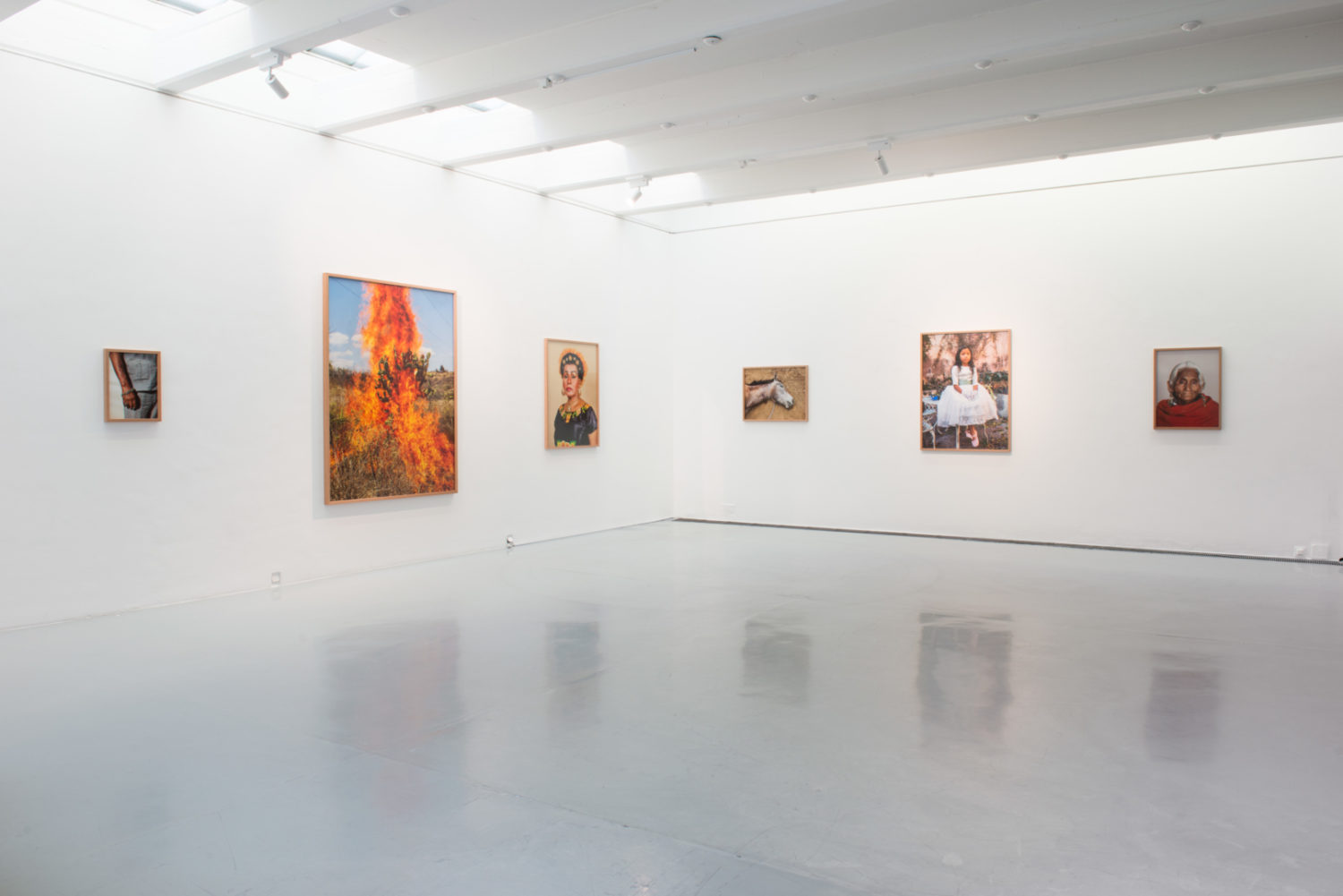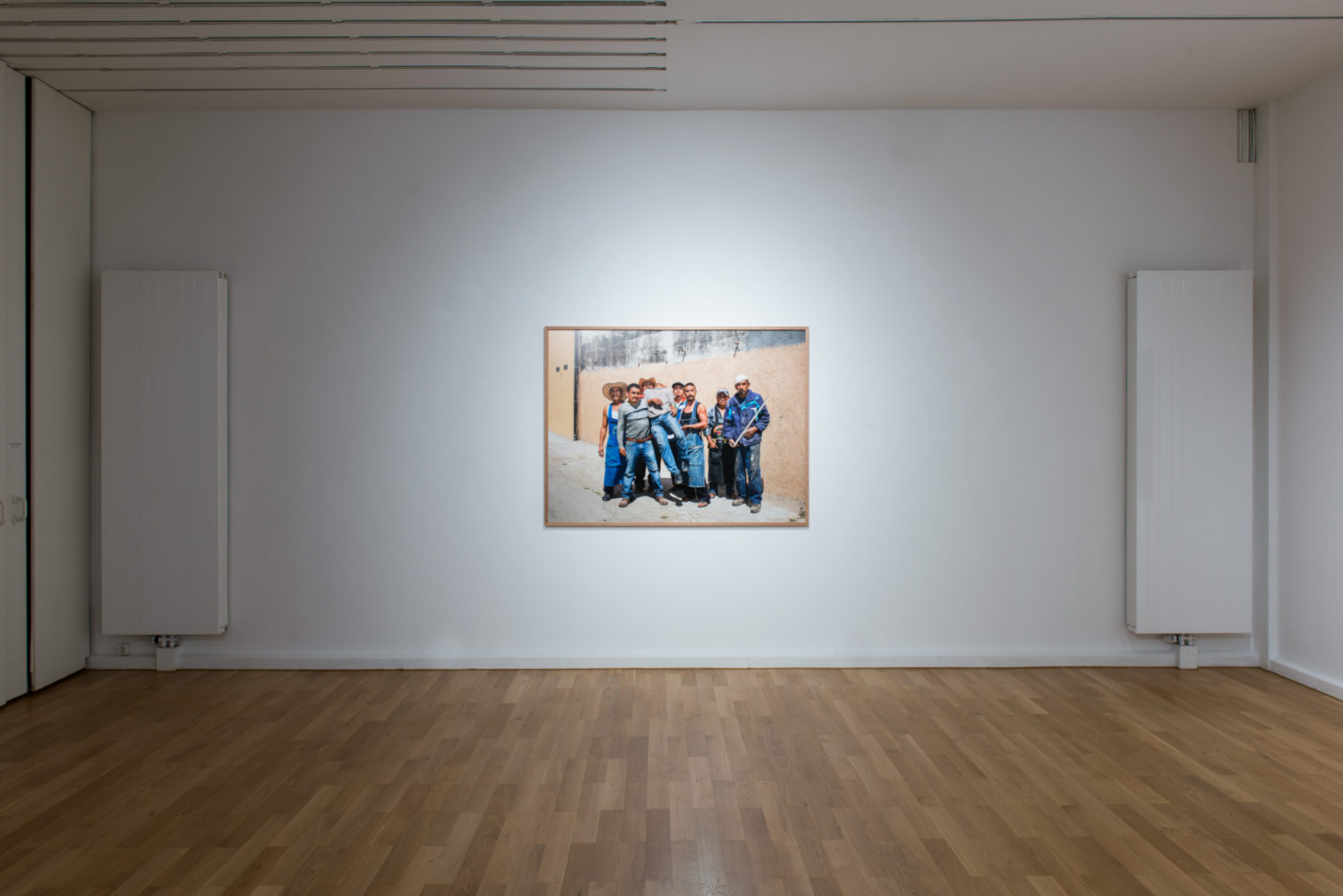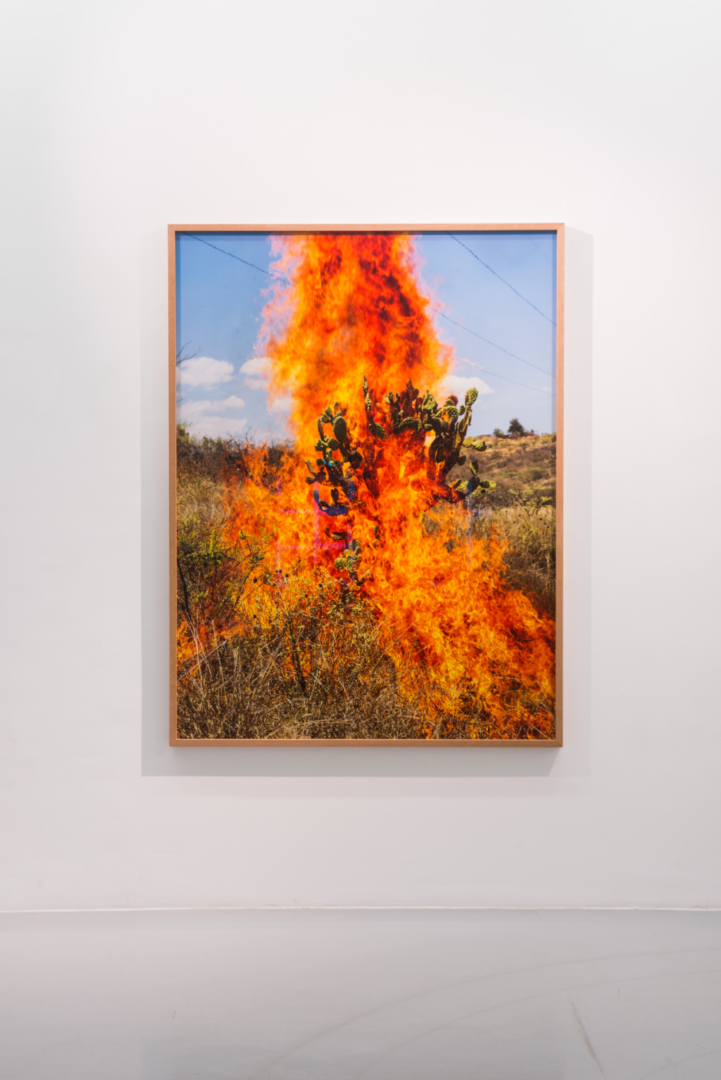PIETER HUGO
La Cucaracha
Sep 6, 2019 – Nov 23, 2019
3D Tour
Pieter Hugo – LA CUCARACHA
Midcareer
Pieter Hugo ist bekannt für seine eindringlichen Portraits und Alltagsszenen, die an verschiedensten Orten der Welt entstanden sind. Sie vereinen sich zu einem sozialen Gesamtbild, das die aktuellen und radikal kritischen Lebensrealitäten, die Komplexität und Inkonsistenz der Gesellschaft widerspiegelt. In seiner großen Einzelausstellung „Between the Devil and the Deep Blue Sea“ waren von 2016 bis 2018 an den drei Stationen Wolfsburg, Dortmund und Lissabon über 250 Werke aus 15 Werkgruppen ausgestellt. Erstmals seit dieser sehr erfolgreichen Midcareer-Retrospektive präsentiert Pieter Hugo mit 42 Jahren nun seine neueste Serie. Dies ist bereits Pieter Hugos vierte Einzelausstellung bei PRISKA PASQUER.
Premiere der neuen Werkgruppe
Seine jüngste Werkgruppe LA CUCARACHA entstand 2018 und 2019 in Mexiko und wird vom 6. September bis 23. November 2019 von PRISKA PASQUER erstmals in Europa vorgestellt. Die Fotoserie zeigt Menschen und Situationen, denen er während seiner insgesamt vier mehrwöchigen Aufenthalte vor allem in Mexico City, Oaxaca de Juárez, Juchitán, Hermosillo und an anderen Orten begegnet ist. In den Portraits und Stillleben tritt die Offenheit des Reisenden für ebenso exemplarische wie unerwartete Situationen zutage.
Mexikanisches Panorama
Starke Farben, überbordende Vegetation, kraftvolles Leben und die für europäische Augen ungewohnte Sichtbarkeit von Tod und Vergänglichkeit sprechen aus den atemberaubend intensiven Bildern dieser Werkgruppe. Besonders beeindruckt war Pieter Hugo von der visuellen Sensibilität der mexikanischen Kulturen und von der Koexistenz der Kontraste im Land. Gewalt und Gemeinschaftssinn, Verfall und Eros, Freude und Tragik, Extravaganz und Banalität hat er als gleichermaßen präsent erlebt.
Man trifft auf Straßenkehrer, die als Laienspielgruppe Szenen aus einem monumentalen Wandgemälde des Revolutionsmalers David Alfaro Siqueiros nachstellen. Als Revolutionslied wurde auch das titelgebende Volkslied von der Kakerlake „La Cucaracha“ im mexikanischen Bürgerkrieg der 1920er Jahre, das ebenso von Rebellen wie von den Soldaten des Diktators als Satire auf die Gegenseite umgedichtet wurde. Bis heute gibt es immer wieder karikierende Textvarianten des Lieds mit Bezug zu Themen der jeweiligen Zeit. Eine Portraitreihe zeigt die ausgeprägte Transgender-Kultur der „Muxe“ von Juchitán, in der sich Pieter Hugo mehr für die Erscheinung und den Ausdruck einer älteren Generation interessierte als für den häufiger dargestellten, klischeehaften Jugendkult. Junge Menschen, alte Menschen, Hochzeit, Prostitution, Kampfsport, Rinderschlachtung, Nudistenstrand, und eine gerichtsmedizinische Station – die Motive zeigen die ganze Bandbreite der Comédie Humaine. So leben Menschen miteinander – in ihrer Zeit, an bestimmten Orten und in dieser einen Welt.
Portraits
Eine Konstante in seiner Arbeit ist der tiefe Respekt des Fotografen vor seinen Protagonisten, deren Würde immer intakt bleibt. Seine Portraits sind keine Schnappschüsse, sondern sorgfältig in klassischen, statischen Positionen ausgeführt. Dem Fotografen wie dem Fotografierten geben sie den Raum und die Möglichkeit, die äußere Erscheinung mit der inneren Haltung, und die allgemeinen Lebensumstände mit den individuellen Hintergründen in einem gegenseitigen Blick zu konzentrieren. Die Wahrheit ist in der Schnittmenge zwischen Selbstverständnis und Fremdwahrnehmung zu suchen. Zu finden ist sie ganz sicher in der Authentizität und in der Unmittelbarkeit der persönlichen Begegnung, die sich auf den Betrachter überträgt.
Der Künstler
Pieter Hugo (* 1976 in Johannesburg) lebt und arbeitet in Kapstadt, Südafrika. Bedeutende museale Einzelausstellungen fanden unter anderem im Berardo-Museum in Lissabon, im Kunstmuseum Wolfsburg, im Museum für Fotografie Den Haag, im Musée de l’Elysée in Lausanne, im Ludwig-Museum in Budapest, im Fotografiska in Stockholm und im MAXXI in Rom statt. Er hat mehrere Fotobücher veröffentlicht, die mit großem Kritikerlob aufgenommen wurden. Hugo wurde 2012 für den Deutsche Börse Photography Prize nominiert. 2015 war er der Künstler ‘In Focus’ für den Taylor Wessing Photographic Portrait Prize in der National Portrait Gallery in London und für den sechsten Zyklus des Prix Pictet nominiert.
Artist Statement
Finding a home for your demons
I first came to Mexico at the invitation of Francisco Berzunza. He was curating an exhibition of South African art at a museum in Oaxaca and wanted me to make new work for the show. The exhibition was titled Hacer Noche (‘Crossing Night’) and dealt with the liminal space after death. His only brief to me was that the work be about sex and mortality.
What started as an open assignment quickly became an obsession, leading to four trips over two years, each almost a month long. Mexico’s anarchic, visceral energy got under my skin and sucked me in.
The country has a particular ethos and aesthetic; there is an acceptance that life has no glorious victory, no happy ending. Humour, ritual, a strong sense of community and an embrace of the inevitable make it possible to live with tragic and often unacceptable situations.
There is a very different relationship with death here to what I am used to. If one looks beyond the clichés of dancing skeletons and sugar skulls, there’s a deeply complicated connection with mortality. This necropolitical dynamic is most visible in contradictory expressions of honouring the afterlife, in the Day of the Dead celebrations and the brutal dismemberment of bodies by narco traffickers.
Alongside the flamboyance and high-pitched register of this series, there is the ordinariness of the everyday. I am drawn to the fabulousness of the banal and the banality of the exotic.
Given the disparate nature of my interests, I’ve always struggled to situate myself. One could say, albeit reductively, that my work has always been about the outsider – and in the Trump era, Mexico is definitely the outsider.
La Cucaracha, the Spanish folk song after which this work was named, is of contested origin. While its basis has remained the same, describing a cockroach that has lost a leg or two and struggles to walk, its many verses have been improvised according to the needs of the moment. Historians have traced the song as far back as the early 1800s, yet it is widely accepted that it gained prominence during the Mexican Revolution when rebel and government forces alike invented lyrics that commented on major political figures, the events of the war and its effects on civilians. Contemporary versions have referenced marijuana use and been performed by Looney Tunes character Speedy Gonzales.
The jingle-like refrain, combining humour and derogation, is tied deeply to the specific geopolitical, historical and pop-cultural expression of Mexico – a place where hyperviolence, the joyful treatment of death, extreme machismo, expanded viewpoints on gender, dogmatic Catholicism, a reverence for the supernatural, cyclic autocracies, the provision of equitable social housing, chronic desperation and a communal outlook have all somehow found a way to coexist.
Pieter Hugo, July 2019
Pieter Hugo – LA CUCARACHA
Mid-career
Pieter Hugo is well known for his urgent portraits and everyday scenes captured at a wide variety of locations around the world. They come together to form a social “big picture” that reflects the current and radically critical everyday realities, and the complexity and inconsistency of modern-day society. Between 2016 and 2018, over 250 works from 15 projects were showcased in Wolfsburg, Dortmund and Lisbon in his major individual exhibition “Between the Devil and the Deep Blue Sea”. For the first time since this highly successful mid-career retrospective, Pieter Hugo – now 42 years old – is presenting a brand new series. This is Pieter Hugo’s fourth solo show at PRISKA PASQUER.
Premiere of new project
His latest project LA CUCARACHA was created in Mexico in 2018 and 2019 and is to be presented in Europe for the first time by PRISKA PASQUER between 6 September and 23 November 2019. This photo series depicts people and situations encountered by the artist during a total of four stays for several weeks, above all in Mexico City, Oaxaca de Juárez, Juchitán and Hermosillo. The portraits and still lifes bring to the fore the travelling artist’s openness towards generic yet unexpected situations.
Mexican panorama
Strong colours, exuberant vegetation, vigorous life and a kind of visibility of death and transience that is unfamiliar to European eyes – all of this is conveyed by the breathtakingly intense images contained in this group of works. Pieter Hugo was particularly impressed by the sensibility of Mexican cultures and by the contrasts that coexist within the country. Violence and community spirit, decay and eros, joy and tragedy, extravagance and banality – the artist saw all of these as being present in equal measure.
We meet street sweepers whose amateur dramatic society recreates scenes from a monumental mural by revolutionary painter David Alfaro Siqueiros. In the Mexican Civil War in the 1920s, the titular folksong “La Cucaracha” – “The Cockroach” – was reworked by both the rebels and the dictator’s soldiers as a satire on one other. To this day, there are always new versions of the song with satirical lyrics referencing present day issues. A series of portraits shows the full-fledged transgender “muxe” culture of Juchitán; here, Pieter Hugo is more interested in the aspect and expression of an older generation than in the stereotypical cult of youth that is more usually shown. Young people, old people, a wedding, prostitution, combat sports, slaughtering of cattle, a nudist beach, and a forensic facility – the images run the entire gamut of the comédie humaine. This is how people live together – in their time, at specific locations and in this one world.
Portraits
One constant element in the photographer’s work is the profound respect he has for his protagonists, whose dignity always remains intact. His portraits are not snapshots, but are carefully executed in classical, static positions. They give the photographer and his subjects the space and scope they need to condense into a two-way observation the outer appearance with inner attitude and general life circumstances with individual backgrounds. The truth is to be sought where self-image and external perception overlap. And it is doubtless to be found in the authenticity and immediacy of the personal encounter that is transferred to the observer.
The artist
Born in Johannesburg in 1976, Pieter Hugo lives and works in Cape Town, South Africa. The major individual exhibitions of his work in museums around the world include the Berardo Collection Museum in Lisbon, Kunstmuseum Wolfsburg, The Hague Museum of Photography, Musée de l’Elysée in Lausanne, the Ludwig Museum in Budapest, Fotografiska in Stockholm and MAXXI in Rome. He has published a number of photo books to great critical acclaim. Hugo was nominated for the Deutsche Börse Photography Prize in 2012. In 2015, he was the “Artist in Focus” for the Taylor Wessing Photographic Portrait Prize in London’s National Portrait Gallery and was nominated for the sixth cycle of the Prix Pictet.
Artist Statement
Finding a home for your demons
I first came to Mexico at the invitation of Francisco Berzunza. He was curating an exhibition of South African art at a museum in Oaxaca and wanted me to make new work for the show. The exhibition was titled Hacer Noche (‘Crossing Night’) and dealt with the liminal space after death. His only brief to me was that the work be about sex and mortality.
What started as an open assignment quickly became an obsession, leading to four trips over two years, each almost a month long. Mexico’s anarchic, visceral energy got under my skin and sucked me in.
The country has a particular ethos and aesthetic; there is an acceptance that life has no glorious victory, no happy ending. Humour, ritual, a strong sense of community and an embrace of the inevitable make it possible to live with tragic and often unacceptable situations.
There is a very different relationship with death here to what I am used to. If one looks beyond the clichés of dancing skeletons and sugar skulls, there’s a deeply complicated connection with mortality. This necropolitical dynamic is most visible in contradictory expressions of honouring the afterlife, in the Day of the Dead celebrations and the brutal dismemberment of bodies by narco traffickers.
Alongside the flamboyance and high-pitched register of this series, there is the ordinariness of the everyday. I am drawn to the fabulousness of the banal and the banality of the exotic.
Given the disparate nature of my interests, I’ve always struggled to situate myself. One could say, albeit reductively, that my work has always been about the outsider – and in the Trump era, Mexico is definitely the outsider.
La Cucaracha, the Spanish folk song after which this work was named, is of contested origin. While its basis has remained the same, describing a cockroach that has lost a leg or two and struggles to walk, its many verses have been improvised according to the needs of the moment. Historians have traced the song as far back as the early 1800s, yet it is widely accepted that it gained prominence during the Mexican Revolution when rebel and government forces alike invented lyrics that commented on major political figures, the events of the war and its effects on civilians. Contemporary versions have referenced marijuana use and been performed by Looney Tunes character Speedy Gonzales.
The jingle-like refrain, combining humour and derogation, is tied deeply to the specific geopolitical, historical and pop-cultural expression of Mexico – a place where hyperviolence, the joyful treatment of death, extreme machismo, expanded viewpoints on gender, dogmatic Catholicism, a reverence for the supernatural, cyclic autocracies, the provision of equitable social housing, chronic desperation and a communal outlook have all somehow found a way to coexist.
Pieter Hugo, July 2019





















